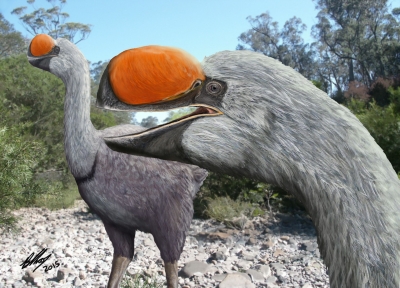Sex life of Earth’s Biggest Bird.


Reconstruction of Dromornis stirtoni, the giant bird that stood 3m tall and weighed about 480 kg. Picture by Brian Choo of Flinders University, Adelaide, Australia.
The mihirungs, of the family Dromornithidae, were giant flightless birds unique to Australia. They originated more than 25 million years ago and Genyornis, the last member of this group, went extinct in the late Pleistocene about 50,000 years ago. Their fossils are rare and fragmentary, so the biology of these birds is largely unknown.
The largest of all mihirungs, Dromornis stirtoni roamed Australia about 8 million years ago. They died in their dozens around a shrinking waterhole in the Northern Territory along with many marsupials, including sheep to cow-sized herbivores and their predators, distant relatives of the marsupial lion.
Today, the huge bones of this distant relative of ducks, fragmented and fractured by the ravages of time, are awe-inspiring to those that see them. Now, sleuthing by an international team, led by Australian palaeontologists have revealed long hidden biology of Stirton’s mihirung in a recently published article in the highly regarded Journal of Vertebrate Paleontology.
Stirton’s mihirung was truly enormous. It stood two metres high at its back and with its neck and half metre long head could reach well over three metres. “It was probably the largest bird ever to have lived. With an average weight of 480 kg, it was more than ten times the weight of an emu.” said Warren Handley of Flinders University of South Australia.
“But it had a large size range, so the question arose, were there one or two species?” said Adam Yates, a co-author based at the Museum of Central Australia in Alice Springs, and the custodian of the main collection of these fossils.
Detailed geometric morphometric analysis by Warren Handley as part of his honours research showed that the fossils fell into two distinct size groups of similar-shaped birds. To try and figure out which were males and which were females, the researchers decided to core the leg bones to look for medullary bone, a specialist type of tissue found only in the hollow bones of female birds before they lay eggs. “When we drilled some of the bones, I was astounded to find that a few of them had medullary cavities filled with bone. What were the odds that this was medullary bone?” said Warren Handley. Samples of the bones were sent to South African palaeobiologist and specialist in bone histology, Professor Anusuya Chinsamy-Turan of the Department of Biological Sciences at the University of Cape Town, who prepared thin sections of the bone for microscopy. Professor Chinsamy-Turan says, “It was quite a surprise to find that four of the birds in our sample had medullary bone. This finding was a real scoop since we now could say with certainty that these were ovulating female mihirungs”.

Scientists involved in the study: Trevor Worthy and Warren Handley from Flinders University in Adelaide and Anusuya Chinsamy-Turan in the middle
We found that our “females” belonged to the group of smaller D. stirtoni individuals, with an averaged mass of 451 kg (370–543 kg), suggesting that the species was clearly sexually dimorphic. The larger males had a mass averaging 528 kg, with some reaching a massive 610 kg in weight, much larger than elephant birds Aepyornis maximus of Madagascar, or the giant moa Dinornis robustus of New Zealand.
The large terrestrial birds that survive today are all ratites (e.g., the largest of which are the ostriches that weigh in at about 145 kg, and the smaller 40 kg cassowary and emu). Among ostriches, the males are larger than the females, while in most other ratites, the females are the larger sex. Our results for the Stirton’s mihirungs show that the males were larger and equally abundant as females, and so a breeding behaviour more like geese can be inferred. Most likely, they mated for life, the females brooded the eggs, and both sexes aggressively defended nests and shared parental care. With their huge size, they were capable of protecting the growing chicks from predators, such as the dog-sized ancestral thylacines and marsupial lions that were around at the time.
“This study provides a spectacular example of how the integration of multidisciplinary techniques and collaboration can reveal details of the biology of long extinct animals from their fragmented osseous remains” said Trevor Worthy, of Flinders University.